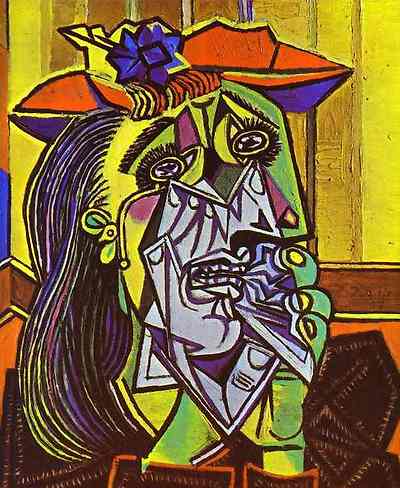|
파블로 피카소의 [우는 여인] Weeping Woman
캔버스에 오일로 그려졌으며, 영국 런던의 테이트 갤러리에 소장되어 있다. 프랑스의 입체파 화가 피카소 작품이다. 피카소는 91년간의 생애 중 80여 년을 미술에 바친 대가로서, 회화·조각·소묘·도자기 등 다양한 분야에서 많은 작품을 남김으로써 20세기 현대미술의 발전에 크게 이바지하였다. 이 작품은 에스파냐내란을 주제로 전쟁의 비극성을 표현한 피카소의 대표작《게르니카 Guernica》의 습작에서 시작되었다. 피카소는 이 주제에 매료되어 《게르니카》를 완성한 후에도 여러 점을 제작하였다. 즉, 여인들에게 많은 변화를 주어 작품을 만들었는데, 《잠자는 여인》《춤추는 여인》 《독서하는 여인》 《거울을 보는 여인》 《포옹하는 여인》 등 그 변화는 매우 다양하다. 전쟁의 비극을 통한 여인들의 슬픔을 상징화한 작품으로, 울고 있는 여인의 얼굴을 입체적으로 분해한 뒤 재조립하는 피카소 특유의 표현법으로 제작되었다. 배경의 검은색 속에서 선명하게 얼굴과 손이 부상하고 있다. 눈물을 그린 것도 사실적인 것을 피하고 추상적이며, 흐르는 것이 아니라 튀어나오는 듯이 표현하고 있다. 마치 아동화같이 소박하고도 상징적으로 표현한 피카소의 걸작 중의 하나이다. 이 작품의 모델은 에스파냐내란이 한창 진행 중이던 시절에 만난 피카소의 다섯번째 연인 도라 마르이다. 이 여자는 《게르니카》을 그리는 데 많은 영감을 주기도 했는데, 의문의 자살로 생을 마감하였다. This is a study of how much pain can be communicated by a human face. It has the features of a specific person, Dora Maar, whom Picasso described as "always weeping". She was in fact his close collaborator in the time of his life when he was most involved with politics. Let your eyes wander over the sharp surface and you are led by the jagged black lines to the picture's centre, her mouth and chin, where the flesh seems to have been peeled away by corrosive tears to reveal hard white bone. The handkerchief she stuffs in her mouth is like a shard of glass. Her eyes are black apertures. When you are inside this picture you are inside pain; it hits you like a punch in the stomach. Picasso's insistence that we imagine ourselves into the excoriated face of this woman, into her dark eyes, was part of his response to seeing newspaper photographs of the Luftwaffe's bombing of Guernica on behalf of Franco in the Spanish civil war on April 26, 1937. This painting came at the end of the series of paintings, prints and drawings that Picasso made in protest. It has very personal, Spanish sources. In May 1937 Picasso's mother wrote to him from Barcelona that smoke from the burning city during the fighting made her eyes water. The Mater Dolorosa, the weeping Virgin, is a traditional image in Spanish art, often represented in lurid baroque sculptures with glass tears, like the very solid one that flows towards this woman's right ear. Picasso's father, an artist, made one for the family home. This painting takes such associations and chews them to pulp. It is about the violence that we feel when we look at it, about translating the rawest human emotion into paint. Its origins lie in the tortured figures of Picasso's Guernica (1937), whose suffering is calculated to convey you beyond the photographs of the bombing to sense momentarily what it was to be there. In Guernica there is a screaming woman holding her dead baby, her tongue a dagger pointing at heaven. The baby's face is a cartoon of death. Picasso followed Guernica with his series of Weeping Woman paintings in which the woman's mourning continues, without end. She cries and cries. In different versions the Weeping Woman's face is crushed to an abject lump, twisted out of recognition. Extract from an article by Jonathan Jones, May 13, 2000, The Guardian
Linked from : |
